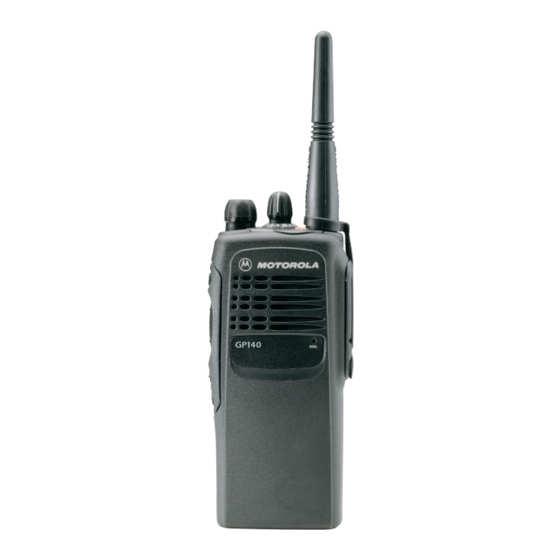Motorola GP140 Series Panduan Pengguna - Halaman 18
Jelajahi secara online atau unduh pdf Panduan Pengguna untuk Radio Portabel Motorola GP140 Series. Motorola GP140 Series 20 halaman. Professional radio, power distribution and controller
Juga untuk Motorola GP140 Series: Informasi Layanan (32 halaman), Informasi Layanan (30 halaman), Panduan Servis Dasar (46 halaman), Informasi Layanan (30 halaman)

Portable Radio Operation and
EME Exposure
When transmitting with a portable radio,
hold the radio in a vertical position with
its microphone 2.5 to 5 cm away from your mouth.
Keep antenna at least 2.5 cm from your head and
body.
If you wear a portable Two-Way radio on your body,
ensure that the antenna is at least 2.5 cm from your
body when transmitting.
Electromagnetic Interference/Compatibility
NOTE: Nearly
every
susceptible to electromagnetic interference
(EMI) if inadequately shielded, designed or
otherwise configured for electromagnetic
compatibility.
To avoid electromagnetic interference and/or
compatibility conflicts, turn off your radio in any
facility where posted notices instruct you to do so.
Hospitals or health care facilities may be using
equipment that is sensitive to external RF energy.
When instructed to do so, turn off your radio when
on board an aircraft. Any use of a radio must be in
accordance with airline regulations or crew
instructions.
English
16
electronic
device
is
Operational Warnings
Vehicles With an Air Bag
Do not place a portable radio in the area over an air
bag or in the air bag deployment area. Air bags
inflate with great force. If a portable radio is placed
in the air bag deployment area and the air bag
inflates, the radio may be propelled with great force
and cause serious injury to occupants of the vehicle.
Potentially Explosive Atmospheres
Turn off your two-way radio when you are in any
area with a potentially explosive atmosphere, unless
it is a radio type especially qualified for use in such
areas (for example, Factory Mutual or CENELEC
Approved). Sparks in a potentially explosive
atmosphere can cause an explosion or fire resulting
in bodily injury or even death.
Batteries
Do not replace or recharge batteries in a potentially
explosive atmosphere. Contact sparking may occur
while installing or removing batteries and cause an
explosion.
!
!
W A R N I N G
